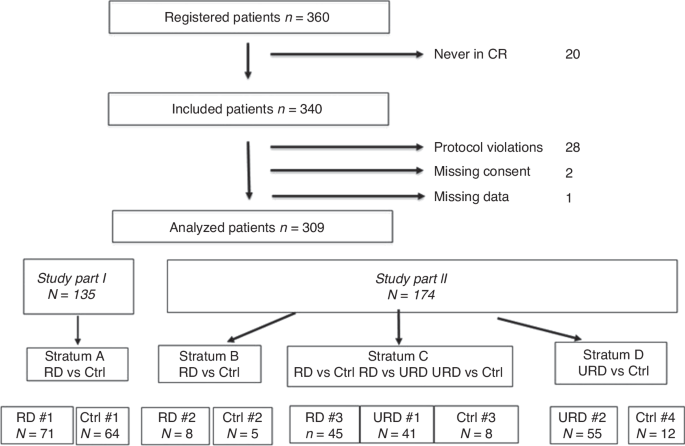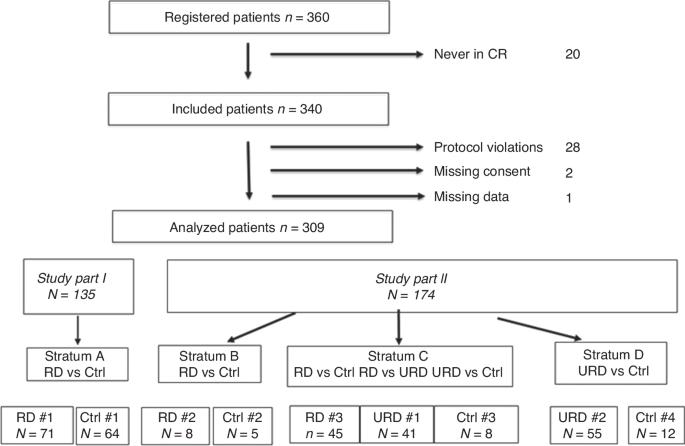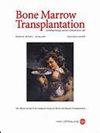Reduced Intensity transplantation vs chemotherapy in CR1. A prospective, pseudorandomized study in 50–70 year old AML patients
IF 4.5
2区 医学
Q1 HEMATOLOGY
引用次数: 0
Abstract
The aim of this prospective, international multicenter, pseudorandomized study comparing RICT HCT to standard-of-care chemotherapy in intermediate- or high-risk AML patients 50–70 years using the donor versus no-donor concept. Part 1 included only patients with potential family donors (RD) at the date of HLA-typing of the first potential sibling or CR-date, if later. Part 2 allowed the inclusion of patients without a possible sibling donor using the start of an unrelated donor (URD) search as inclusion date. 360 patients were registered and 309 analyzed. The median follow-up was 47 months (1–168). There was no difference in overall survival (OS) between the RD (n = 124) and the Control (n = 77) groups (p = 0.50, 3-year OS RD: 0.41(95% CI; 0.32–0.50); Controls: 0.49 (95% CI; 0.37–0.59)). The main cause of death was relapse (67% RD; 88% Controls). In Part 2, the 3-year OS was 0.60 (95% CI 0.50–0.70) for URD-HCT (n = 86) and 0.37 (95% CI 0.13–0.62) for Controls (n = 20), respectively (p = 0.10). When analyzing transplanted patients (Part 2), the OS at 3-years was higher for URD-HCT than RD-HCT (0.67 (0.55–0.76) vs. 0.42 (0.26–0.57; p = 0.005). This study doesn’t support elderly HLA-identical siblings as donors for older AML patients undergoing a RICT allogeneic HCT in first CR.


CR1 期患者的低强度移植与化疗。一项针对 50-70 岁急性髓细胞白血病患者的前瞻性假随机研究。
这项前瞻性国际多中心假随机研究的目的是,采用供体与非供体的概念,比较 50-70 岁中危或高危急性髓细胞性白血病患者的 RICT HCT 与常规化疗。第 1 部分仅纳入在第一个潜在兄弟姐妹的 HLA 分型日期或 CR 日期(如果晚于 CR 日期)有潜在家族供体 (RD) 的患者。第 2 部分允许纳入没有可能的兄弟姐妹供体的患者,将非亲属供体(URD)搜索的开始日期作为纳入日期。共登记了 360 名患者,分析了 309 名患者。中位随访时间为 47 个月(1-168 个月)。RD组(n = 124)和对照组(n = 77)的总生存率(OS)没有差异(P = 0.50,3年OS RD:0.41(95% CI;0.32-0.50);对照组:0.49(95% CI;0.49-0.50)):0.49(95% CI;0.37-0.59))。死亡的主要原因是复发(67% RD;88% 对照组)。在第二部分中,URD-HCT(n = 86)和对照组(n = 20)的3年OS分别为0.60(95% CI 0.50-0.70)和0.37(95% CI 0.13-0.62)(P = 0.10)。在分析移植患者(第2部分)时,URD-HCT的3年OS高于RD-HCT(0.67 (0.55-0.76) vs. 0.42 (0.26-0.57; p = 0.005))。本研究不支持年长的HLA相同兄弟姐妹作为首次CR接受RICT异基因造血干细胞移植的老年AML患者的供体。
本文章由计算机程序翻译,如有差异,请以英文原文为准。
求助全文
约1分钟内获得全文
求助全文
来源期刊

Bone Marrow Transplantation
医学-免疫学
CiteScore
8.40
自引率
8.30%
发文量
337
审稿时长
6 months
期刊介绍:
Bone Marrow Transplantation publishes high quality, peer reviewed original research that addresses all aspects of basic biology and clinical use of haemopoietic stem cell transplantation.
The broad scope of the journal thus encompasses topics such as stem cell biology, e.g., kinetics and cytokine control, transplantation immunology e.g., HLA and matching techniques, translational research, and clinical results of specific transplant protocols. Bone Marrow Transplantation publishes 24 issues a year.
 求助内容:
求助内容: 应助结果提醒方式:
应助结果提醒方式:


